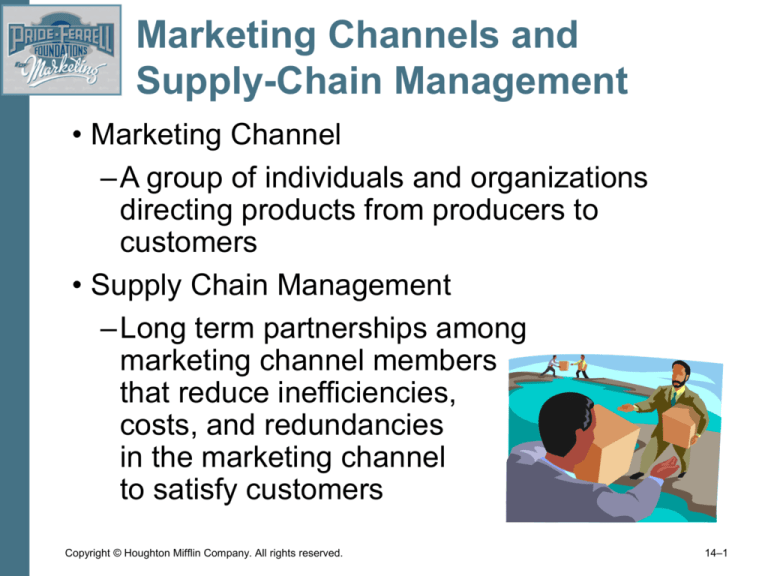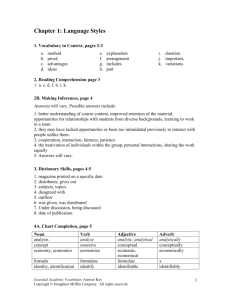
Marketing Channels and
Supply-Chain Management
• Marketing Channel
–A group of individuals and organizations
directing products from producers to
customers
• Supply Chain Management
–Long term partnerships among
marketing channel members
that reduce inefficiencies,
costs, and redundancies
in the marketing channel
to satisfy customers
Copyright © Houghton Mifflin Company. All rights reserved.
14–1
Marketing Channels Consist of
Intermediaries
• Marketing Intermediary
–An intermediary linking producers to other
intermediaries or to ultimate consumers
through contractual arrangements or through
the purchase and resale of products
Producer
Direct Channel
Customer
Indirect Channel
Producer
Intermediary
Copyright © Houghton Mifflin Company. All rights reserved.
Customer
14–2
Marketing Channels Form a
Supply Chain
• Supply-Chain Management
– Long-term partnerships among marketing channel
members that reduce inefficiencies, costs, and
redundancies and develop innovative approaches to
satisfy customers
– Optimizes costs throughout the whole channel for
efficiency and service
– Includes all entities that facilitate product distribution
and benefit from cooperative efforts
– Arises from the need to achieve a more competitive
position
Copyright © Houghton Mifflin Company. All rights reserved.
14–3
Marketing Channels Create
Utility
• Time Utility
– The product is available when the customer wants it
(newspaper delivery).
• Place Utility
– The product is available in locations where
customers wish to purchase it (convenience stores).
• Possession Utility
– The customer has access to the
product to use or to store for future
use (raincoats).
• Form Utility
– The product is assembled, prepared or
otherwise refined to suit customer needs.
Copyright © Houghton Mifflin Company. All rights reserved.
14–4
Marketing Channels Facilitate
Exchange Efficiencies
• Reduce the overall costs of market exchanges
• Reduce search costs for customers
• Maintain order in the marketplace
Copyright © Houghton Mifflin Company. All rights reserved.
14–5
Efficiency in Exchanges
Provided by an Intermediary
FIGURE 14.1
Copyright © Houghton Mifflin Company. All rights reserved.
14–6
Typical Marketing Channels for
Consumer Products
FIGURE 14.2
Copyright © Houghton Mifflin Company. All rights reserved.
14–7
Typical Marketing Channels for
Business Products
FIGURE 14.3
Copyright © Houghton Mifflin Company. All rights reserved.
14–8
Distribution Intermediaries
• Industrial Distributor
–An independent business that takes title to
business products and carries inventories
• Manufacturers’ Agent
–An independent businessperson who sells,
on commission, the complementary products
of several producers; does not takes title to
or hold inventories.
Copyright © Houghton Mifflin Company. All rights reserved.
14–9
Multiple Marketing Channels
and Channel Alliances
• Dual Distribution
–The use of two or more channels to distribute
the same product to the same target market
• Strategic Channel Alliance
–An agreement whereby the products of one
organization are distributed through the
marketing channels of another
Copyright © Houghton Mifflin Company. All rights reserved.
14–10
Channel Leadership,
Cooperation, and Conflict
• Channel Captain
–A dominant member (producer, wholesaler,
or retailer) of a marketing channel or supply
chain
• Establishes channel policies and coordinates
development of the marketing mix
• Channel Power
–The ability of one channel
member to influence another
member’s goal achievement
Copyright © Houghton Mifflin Company. All rights reserved.
14–11
Channel Conflict
• Sources of Channel Conflict
– Disagreements arising among channel members
– Communication difficulties jeopardizing coordination
– Increased use of multiple distribution channels by
manufacturers creating conflicts with distributors and
retailers
– Intermediaries diversifying into and offering
competing products
– Producers attempting to circumvent intermediaries
and dealing directly with retailers
Copyright © Houghton Mifflin Company. All rights reserved.
14–12
Channel Cooperation
• Improving Channel Cooperation
–Unifying channel to maintain market order
–Agreeing to direct efforts toward common
objectives
–Precisely defining each
channel member’s tasks
Copyright © Houghton Mifflin Company. All rights reserved.
14–13
Channel Integration
• Vertical Channel Integration
– Two or more stages of the marketing channel are
under one management.
– Channel members coordinate their efforts to reach a
target market.
• Vertical Marketing System (VMS)
– A marketing channel managed by a single channel
member to achieve efficient, low-cost distribution
• Corporate VMS
• Administered VMS
• Contractual VMS
Copyright © Houghton Mifflin Company. All rights reserved.
14–14
Channel Integration (cont’d)
• Horizontal Integration
–Organizations at the same level of operation
are combined under one management.
Copyright © Houghton Mifflin Company. All rights reserved.
14–15
Intensity of Market Coverage
• Intensive Distribution
–Uses all available outlets to distribute a
product.
• Appropriate for convenience products with high
replacement rates
• Provides availability and
reduces search time
Copyright © Houghton Mifflin Company. All rights reserved.
14–16
Intensity of Market Coverage
(cont’d)
• Selective Distribution
–Uses only some available outlets to distribute
a product
• Appropriate for shopping products and
durable goods with low
Tuscaloosa’s Only
replacement rates
Authorized Dealer
• Desirable when special effort—
such as customer service—
is important
Copyright © Houghton Mifflin Company. All rights reserved.
14–17
Intensity of Market Coverage
(cont’d)
• Exclusive Distribution
–Uses a single outlet in a fairly large
geographic area to distribute a product
• Appropriate for expensive, high-quality products
purchased infrequently
Copyright © Houghton Mifflin Company. All rights reserved.
14–18

